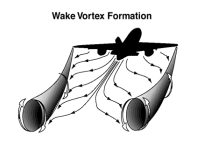Tue, Jul 29, 2003
Flight Safety Technologies Hopes To Find Out Who's Stirring
Things Around Up There
 The US House of
Representatives has voted to approve a fiscal year 2004 NASA
appropriation which includes $5 million specifically for Project
Socrates. Socrates is a propriety technology that Flight Safety
Technologies is developing to detect, locate and track dangerous
airplane wake vortex turbulence.
The US House of
Representatives has voted to approve a fiscal year 2004 NASA
appropriation which includes $5 million specifically for Project
Socrates. Socrates is a propriety technology that Flight Safety
Technologies is developing to detect, locate and track dangerous
airplane wake vortex turbulence.
The FY 2004 NASA funding still must be approved by a
Senate/House Conference and then signed into law by the President
before becoming a firm budget item. Thereafter, the company must
negotiate and execute a contract and obtain approval for specific
work orders before it receives contract revenue from such funding.
While the company expects to receive a portion of these funds,
there is no assurance as to how much, if any, of these funds will
be received by Flight Safety Technologies.
How They'll Spend Our Money
Flight Safety Technologies plans to utilize about $4 Million of
FY 2003 funds, previously voted by the Congress and approved by the
President and which have been recently transferred to the US
Department of Transportation's, Volpe National Transportation
Systems Center in Cambridge (MA) to expand the Socrates technology
from its present four beam configuration to a more capable, eight
(or more) beam system. None of these funds have yet been received
but the company is currently discussing a contract and work orders
with Volpe and anticipates contract action on these funds within
the next few months.
 Flight Safety Technologies
has previously completed two tests of its patented Socrates
technology and has received approval and FY 2002 contract funding
from NASA and Volpe for a third test of its upgraded technology as
part of the Government's wake acoustic testing project that it is
set to commence in mid-August of 2003 at Denver International
Airport.
Flight Safety Technologies
has previously completed two tests of its patented Socrates
technology and has received approval and FY 2002 contract funding
from NASA and Volpe for a third test of its upgraded technology as
part of the Government's wake acoustic testing project that it is
set to commence in mid-August of 2003 at Denver International
Airport.
If the FY 2004 funds become available, the company plans to use
those funds to test the eight (or more) beam configuration at a
major airport site sometime next year.
In considering the reauthorization of the Flight 100 Bill, the
House has recommended authorization of up to $20 Million per year
for the four years FY 2004-2007 that may be used to document and
demonstrate the operational benefits of a wake vortex advisory
system, which could include the company's Socrates technology. This
funding must be authorized by a Senate/House conference and then
signed by the President before it becomes law.
More News
Its Offerings Are Lighter, Cleaner, and Now Pushing Past 1,000nm on SAF Jet Fuel DeltaHawk’s diesel-powered aircraft lineup has seen incredible upgrades over the last few yea>[...]
The Airplane Experienced A Total Loss Of Engine Power On December 3, 2025, about 1600 central standard time, a Mooney Aircraft Corp. M20K, N57229, was substantially damaged when it>[...]
Make Sure You NEVER Miss A New Story From Aero-News Network Do you ever feel like you never see posts from a certain person or page on Facebook or Instagram? Here’s how you c>[...]
Aero Linx: European Society of Aerospace Medicine (ESAM) As a pan-European, independent forum, it works to promote the safety and health of all persons involved in aviation and spa>[...]
“We are excited to see Wisk achieve this milestone, and I’m so proud of the team that made it possible. The team at Wisk has built advanced technologies across flight c>[...]
 Aero-TV: DeltaHawks Diesel Power Steps Into the Spotlight
Aero-TV: DeltaHawks Diesel Power Steps Into the Spotlight NTSB Prelim: Mooney Aircraft Corp. M20K
NTSB Prelim: Mooney Aircraft Corp. M20K ANN FAQ: Turn On Post Notifications
ANN FAQ: Turn On Post Notifications ANN's Daily Aero-Linx (12.20.25)
ANN's Daily Aero-Linx (12.20.25) Aero-News: Quote of the Day (12.20.25)
Aero-News: Quote of the Day (12.20.25)




